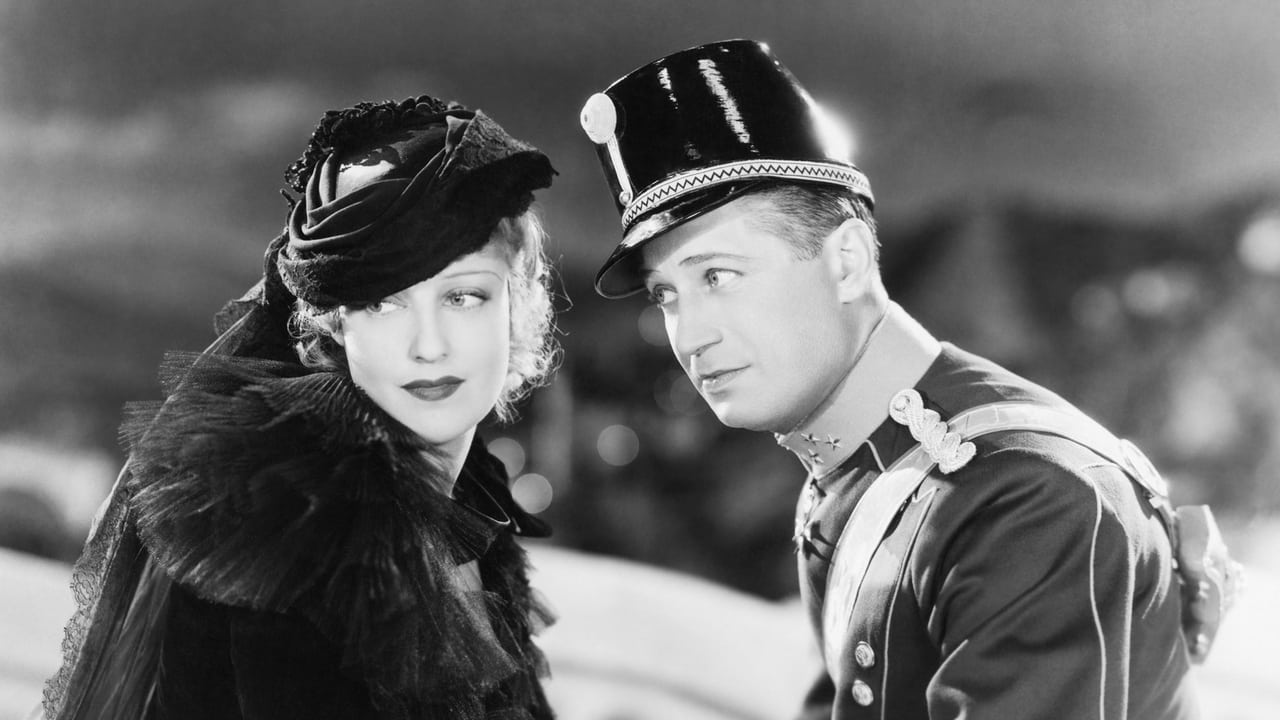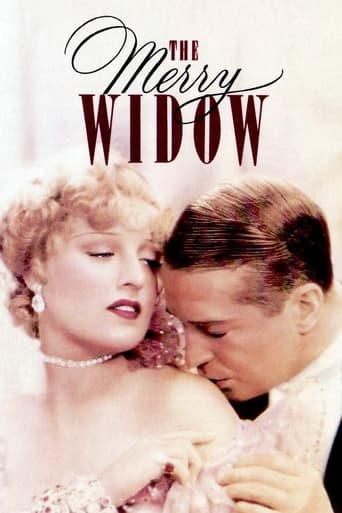

Directed by ERNST LUBITSCH. Based on the 1905 operetta Die Lustige Witwe by Franz Lehar, Victor Leon and Leo Stein. Screenplay: Samson Raphaelson and Ernest Vajda. New lyrics: Lorenz Hart and Gus Kahn. Photographer: Oliver T. Marsh. Art direction: Cedric Gibbons and Frederic Hope. Set decorator: Edwin B. Willis. Film editor: Frances March. Costumes: Ali Hubert. Miss MacDonald's gowns: Adrian. Adapted by Ernst Lubitsch and Marcel Achard. The stage musical was based on the play L'attaché d'Ambassade by Henri Meilhac. Uncredited art direction: Gabriel Scognamillo. Set design: Fred Gabourie. Unit set decorator: Henry Grace. Props: Bert Sperling. Make-up: Robert J. Schiffer. Dance director: Albertina Rasch. Stills: Ted Allen. Music orchestrations: Paul Marquardt, Leonid Raab, Charles Maxwell. Gaffer: Ted Wurtenberg. 2nd camera operator: Lester White. Assistant cameraman: Johnny Greer. Stagemen: Carl West, F.D. Raymond. Waltz instructor for Miss MacDonald: Bert Spencer. Grips: Harry Reid, Art Spang. Business manager: Eric Locke. Assistant directors: Joseph M. Newman, Joe Lefert. Sound mixers: James Brock, Mike McLaughlin. Sound: Douglas Shearer. Musical adaptation: Herbert Stothart.* Producer: Irving Thalberg.Copyright 27 October 1934 by Metro-Goldwyn-Mayer Corp. New York opening at the Astor, 11 October 1934. U.S. release: 2 November 1934. U.K. release: 2 February 1935. Australian release: 10 April 1935. 10 reels. 110 minutes.TV title: The LADY DANCES.SYNOPSIS: Tin-pot European kingdom's economy depends upon the residence and goodwill of a wealthy widow. Boudoir expert Prince Danilo is ordered to Paris to woo her back.NOTES: Academy Award, Art Direction, Cedric Gibbons and Frederic Hope (defeating The Affairs of Cellini and The Gay Divorcée). Negative cost: $1,605,000. Gross domestic rentals: $1,492,000. Previously filmed in 1912 (a two-reeler with Alma Rubens and Wallace Reid) and 1925 (with Mae Murray and John Gilbert, directed by Erich von Stroheim). Re- made in 1952 with Lana Turner and Fernando Lamas.COMMENT: "The Merry Widow" is the best movie ever made. If I were cast ashore on that proverbial desert island and were allowed only one movie for my battery-powered projector, I would choose The Merry Widow. A tuneful, splendidly extravagant delight, impossible to duplicate (I counted over 22 different camera angles in one 3-minute aria by Miss MacDonald), superbly edited and photographed, sparkingly played and sung, with some of the grandest light-opera music ever composed, The Merry Widow is an unbeatable example of cinema art and skill. A lavishly sophisticated entertainment, directed with wit, style and supremely authoritative panache, The Merry Widow is a model on how to over-spend your budget with taste and flair. The art directors deserved their Academy Award for the beguiling sets, but it's scandalous that the picture was not even nominated in other categories. It should have swept away every award from Best Picture to Sound Recording. Chevalier never gave a more ingratiating performance, nor MacDonald a more vibrant, thrilling characterization.OTHER VIEWS: "Comes close to being one of the most perfect film musicals ever made." —The Films of Jeanette MacDonald and Nelson Eddy by Eleanor Knowles
... View MoreWhat a joy this is. I'm sure you have your list of things that you value in film. For me, it is emptiness, narrative asymmetry, layered structure, calligraphic camera meant in the Japanese context.. This has nothing of the sort, and as far as I'm concerned, still manages to be one of the great films of the decade.Nothing except for one thing: paradox. Is this what people refer to when they discuss Lubitsch as the Touch? It could be. I will not say anything about the plot, it's best you go in knowing nothing, it's pretty typical as it is. Basically, you have a man courting a woman three times, but the context and circumscribed situation of their meeting each time changes, and that changes how they know each other. It's a lot of fun, Chevalier and the lovely Jeanette Macdonald have great chemistry. The magic is all in how the bigger picture—the ornate embroidery—is shaped and directed by the continuous stitching of small surprise and paradox. There is all sorts of this, most of it played for laughs. But the core dramatic moments really shine, for instance they each deny having feelings for the other and in the next moment passionately dance together. Isn't this what amazes in life in those few moments when it is really worth the hype? It doesn't go according to script, but spontaneously flows out, bizarrely contradicts itself, a deeper self catches you unaware.By setting it up this way, Lubitsch achieves what only a handful of directors have managed; between obvious setup and paradoxical punchline, that instantaneous space is yours. In that momentarily empty space you deepen yourself by seeing/conciliating in your mind how disparate disharmony can make sense, and by deepening yourself you deepen the characters and world of the film. Lubitsch has set this up so that you stitch. Maybe I was after all wrong about what this film has for it that appeals to me. I will be seeing more from this man, he seems like a gentle, intelligent soul.
... View More114: The Merry Widow (1934) - released 10/11/1934, viewed 9/3/08.DOUG: Criterion just released a Lubitsch box set featuring his sound musicals prior to Trouble In Paradise. Awesome. Now we need one with his work following Paradise, including this lavish piece. Lubitsch favorites Maurice Chavalier and Jeanette MacDonald appear in their last film together; once again she plays a lonely aristocrat, and once again he plays an officer intent on wooing her. This one, however, spares no expense on the costumes, sets, and extras. The always-reliable Edward Everett Horton is also around to pull his weight in a supporting role. For all its loveliness, Lubitsch is in danger of becoming routine, but I don't want that to sound bad; Lubitsch was one of Hollywood's most prolific and most reliable imports at this time, and this is a solid example to be sure. Like all of Lubitsch's best work, this is filled with crackling innuendo and great chemistry, along with lots of fun little moments sprinkled throughout. Overall, though the elements are familiar, everyone is at the top of their game. Definitely recommended, if you can get your hands on it.KEVIN: After powering through all of Ernst Lubitsch's pre-Code essentials, his latest foray feels kinda routine. In a good way though, not unlike going to your favorite restaurant and ordering your favorite dish that you always order, and getting it served just the way you like it. Chevalier plays another playboy in uniform, and MacDonald, with more big, frilly dresses than ever, is another lovelorn upper-class socialite (here the titular obscenely wealthy widow), and the fate of a cash-strapped kingdom depends on their hooking up. Considering that the plot hinges on their union, the film seems to spend copious amounts of time building up to their meeting. Lubitsch regular George Barbier is memorable as the king, but supporting players Edward Everett Horton and Una Merkel are here and gone far too quickly. As enjoyable as this classic is, I can't help wondering if I would appreciate this movie more if I hadn't seen so much of it before.Last film: Cleopatra (1934). Next film: The Gay Divorcée (1934).
... View MoreThe great Ernst Lubitsch clearly understood the material in which "The Merry Widow" was based. Being European himself, he clearly identified with this delightful Franz Lehar operetta that had been charming audiences throughout the years. Mr. Lubitsch places the action in the small country of Marshovia, in central Europe. The director had an eye for the great spectacle he presents for us. Mr. Lubitsch greatest achievement is that he seems to have his camera waltzing all the time. The result is an amazing triumph for MGM.In fact, the glorious sets one admires in the film are breathtaking. For a film made in 1934, the art directors, Cedric Gibbons and Gabriel Scognamillo recreate the royal palace of Marshovia in amazing detail, as well as the Paris scenes with an elegance and good taste that shows the resources of the studio that didn't spare anything. The black and white cinematography of Oliver Marsh enhances the Lubitsch style. Adrian's gowns look luxurious and the editing of the film by Francis Marsh give the film continuity without ever making the action appear forced or staged.The pairing of Maurice Chevalier and Jeanette MacDonald was an match that seems to have been made in haven. Both actors are a delight to see. Mr. Chevalier with his French accent and mannerisms make his Count Danilo the charmer he is. The beautiful Ms. MacDonald is mysterious at first, when we meet her, then as she has fallen in love, changes her attitude and realizes Danilo is the man for her.The secondary roles are played with great panache by the genial Edward Everett Horton, who as the ambassador to Paris, is under orders to have Sonia, the wealthy woman, accept Danilo and return to Marshovia with all her money. George Barber plays the King Achmed and the incomparable Una Merkel is seen as Queen Dolores.The Merry Widow waltz received a great production number in which about a hundred couples are seen dancing around Sonia and Danilo, first in white tuxedos and gowns and later in black ones. Later all the couples are mixed together creating such a rich moment. By today's standards that sequence couldn't have been done, or it must have cost a fortune, or perhaps would have digitally mastered in order not to pay dancers to appear dancing in the movie.Let's just be thankful there was a man with a vision, Ernst Lubitsch, and let's be grateful for his vision and his legacy.
... View More